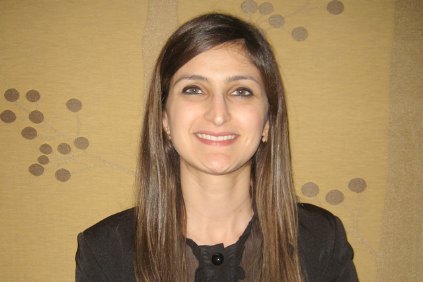User login
BELLEVUE, WASH. – Women who conceive through noninvasive types of medically assisted reproduction are more likely to have a multiple pregnancy and to give birth to an infant with major congenital malformations, according to a meta-analysis reported at the annual meeting of the Teratology Society.
Investigators led by Sonia Chaabane analyzed study-level data from 58 randomized and nonrandomized controlled trials, cohort studies, and case-control studies published between 1966 and 2013. All assessed ovarian stimulation and/or intrauterine insemination, reported outcomes of multiple pregnancy and/or major congenital malformation, and had a comparison group.
Results showed that compared with natural conception, ovarian stimulation alone increased the risk of multiple pregnancy by 11.68-fold and intrauterine insemination (with or rarely without ovarian stimulation) increased the risk by 9.23-fold.
"This can be explained by the hyperstimulation and multiple follicle development," noted Ms. Chaabane, who is a doctoral candidate in pharmacy at the University of Montreal.
Additionally, ovarian stimulation alone increased the risk of major congenital malformation by 1.14-fold and intrauterine insemination increased the risk by 1.32-fold. All these findings were statistically significant.
When it came to specific types of malformations, ovarian stimulation conferred a higher risk of musculoskeletal; nervous system; gastrointestinal; respiratory system; and eye, ear, face, and neck malformations. And intrauterine insemination conferred a higher risk of musculoskeletal and urogenital malformations.
"The biological mechanisms that can explain the association with major congenital malformations is still unclear," Ms. Chaabane commented. "With increased use of these treatments, other observational studies with a larger sample size and having as primary outcome the risk of adverse events in children would address the weakness in the current studies."
Session attendee Richard Miller, Ph.D., professor of obstetrics and gynecology at the University of Rochester (N.Y.), asked, "In the natural conception control group, were these singleton births? And did these studies try to match up this and other factors, and did you take that into account? Because one of the big problems is that these people are at high risk, that’s why they require [intervention], they are not getting pregnant on their own. So they may have risk factors for bad outcomes that need to be taken into account."
"We used the results obtained from different studies, and in those studies, they maybe adjusted for these risk factors and confounders and maybe not. So we used what we had. And it’s true that many factors, such as multiple birth, are major confounders and risk factors for congenital malformations, for example. When we combined the results, we couldn’t take into account these factors," replied Ms. Chaabane.
However, she added, sensitivity analyses could separate studies reporting unadjusted results and studies reporting adjusted results and determine whether the observed associations differ between these groups.
Ms. Chaabane disclosed no relevant conflicts of interest.
BELLEVUE, WASH. – Women who conceive through noninvasive types of medically assisted reproduction are more likely to have a multiple pregnancy and to give birth to an infant with major congenital malformations, according to a meta-analysis reported at the annual meeting of the Teratology Society.
Investigators led by Sonia Chaabane analyzed study-level data from 58 randomized and nonrandomized controlled trials, cohort studies, and case-control studies published between 1966 and 2013. All assessed ovarian stimulation and/or intrauterine insemination, reported outcomes of multiple pregnancy and/or major congenital malformation, and had a comparison group.
Results showed that compared with natural conception, ovarian stimulation alone increased the risk of multiple pregnancy by 11.68-fold and intrauterine insemination (with or rarely without ovarian stimulation) increased the risk by 9.23-fold.
"This can be explained by the hyperstimulation and multiple follicle development," noted Ms. Chaabane, who is a doctoral candidate in pharmacy at the University of Montreal.
Additionally, ovarian stimulation alone increased the risk of major congenital malformation by 1.14-fold and intrauterine insemination increased the risk by 1.32-fold. All these findings were statistically significant.
When it came to specific types of malformations, ovarian stimulation conferred a higher risk of musculoskeletal; nervous system; gastrointestinal; respiratory system; and eye, ear, face, and neck malformations. And intrauterine insemination conferred a higher risk of musculoskeletal and urogenital malformations.
"The biological mechanisms that can explain the association with major congenital malformations is still unclear," Ms. Chaabane commented. "With increased use of these treatments, other observational studies with a larger sample size and having as primary outcome the risk of adverse events in children would address the weakness in the current studies."
Session attendee Richard Miller, Ph.D., professor of obstetrics and gynecology at the University of Rochester (N.Y.), asked, "In the natural conception control group, were these singleton births? And did these studies try to match up this and other factors, and did you take that into account? Because one of the big problems is that these people are at high risk, that’s why they require [intervention], they are not getting pregnant on their own. So they may have risk factors for bad outcomes that need to be taken into account."
"We used the results obtained from different studies, and in those studies, they maybe adjusted for these risk factors and confounders and maybe not. So we used what we had. And it’s true that many factors, such as multiple birth, are major confounders and risk factors for congenital malformations, for example. When we combined the results, we couldn’t take into account these factors," replied Ms. Chaabane.
However, she added, sensitivity analyses could separate studies reporting unadjusted results and studies reporting adjusted results and determine whether the observed associations differ between these groups.
Ms. Chaabane disclosed no relevant conflicts of interest.
BELLEVUE, WASH. – Women who conceive through noninvasive types of medically assisted reproduction are more likely to have a multiple pregnancy and to give birth to an infant with major congenital malformations, according to a meta-analysis reported at the annual meeting of the Teratology Society.
Investigators led by Sonia Chaabane analyzed study-level data from 58 randomized and nonrandomized controlled trials, cohort studies, and case-control studies published between 1966 and 2013. All assessed ovarian stimulation and/or intrauterine insemination, reported outcomes of multiple pregnancy and/or major congenital malformation, and had a comparison group.
Results showed that compared with natural conception, ovarian stimulation alone increased the risk of multiple pregnancy by 11.68-fold and intrauterine insemination (with or rarely without ovarian stimulation) increased the risk by 9.23-fold.
"This can be explained by the hyperstimulation and multiple follicle development," noted Ms. Chaabane, who is a doctoral candidate in pharmacy at the University of Montreal.
Additionally, ovarian stimulation alone increased the risk of major congenital malformation by 1.14-fold and intrauterine insemination increased the risk by 1.32-fold. All these findings were statistically significant.
When it came to specific types of malformations, ovarian stimulation conferred a higher risk of musculoskeletal; nervous system; gastrointestinal; respiratory system; and eye, ear, face, and neck malformations. And intrauterine insemination conferred a higher risk of musculoskeletal and urogenital malformations.
"The biological mechanisms that can explain the association with major congenital malformations is still unclear," Ms. Chaabane commented. "With increased use of these treatments, other observational studies with a larger sample size and having as primary outcome the risk of adverse events in children would address the weakness in the current studies."
Session attendee Richard Miller, Ph.D., professor of obstetrics and gynecology at the University of Rochester (N.Y.), asked, "In the natural conception control group, were these singleton births? And did these studies try to match up this and other factors, and did you take that into account? Because one of the big problems is that these people are at high risk, that’s why they require [intervention], they are not getting pregnant on their own. So they may have risk factors for bad outcomes that need to be taken into account."
"We used the results obtained from different studies, and in those studies, they maybe adjusted for these risk factors and confounders and maybe not. So we used what we had. And it’s true that many factors, such as multiple birth, are major confounders and risk factors for congenital malformations, for example. When we combined the results, we couldn’t take into account these factors," replied Ms. Chaabane.
However, she added, sensitivity analyses could separate studies reporting unadjusted results and studies reporting adjusted results and determine whether the observed associations differ between these groups.
Ms. Chaabane disclosed no relevant conflicts of interest.
AT TERATOLOGY SOCIETY 2014

